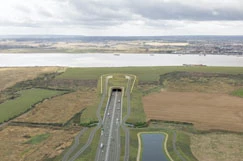The Planning Inspectorate (PINS) has accepted the National Highways planning application for the Lower Thames Crossing for consideration, marking a key step forward for the multi-billion pound scheme.
National Highways pulled its last Development Consent Order (DCO) application in late 2020 based on early feedback from PINS that more information was needed on environmental issues and construction plans.
At the time, National Highways said it expected the delay to be minimal - perhaps as short as 100 days - however it became one of several major road schemes held up by the planning process.
PINS has approximately three months to prepare for the examination.
During this pre-examination stage, the public can register to become an interested party by making a relevant representation. The inspectorate said it would publish the date by which someone can register to become an Interested Party on this application here shortly.
PINS said: 'An examining authority will now be appointed to examine the application. All Interested Parties and other statutory bodies will be notified of the appointment after it has been made.'
National Highways submitted its planning application for the road project on 31 October following a comprehensive programme of assessments, consultation, and engagement with its stakeholders and communities.
National Highways said the planning process is likely to take around 18 months including six months of examination, some taking place at public hearings and that should consent be granted, construction could start as early as 2024.
Matt Palmer, executive director for the Lower Thames Crossing said: 'The Planning Inspectorate has accepted that our comprehensive programme of consultation and design development has been undertaken properly, meaning our plans can now be taken forward for robust and thorough examination by independent, government-appointed experts.'
The project is a new road connecting Kent, Thurrock and Essex through a tunnel beneath the River Thames - estimated to cost between £6.4bn and £8.2bn. The main proposals include:
- approximately 14.5 miles (23km) of new road, with a maximum speed limit of 70mph, connecting to the existing road network from the A2/M2 to the M25;
- two tunnels, one southbound and one northbound;
- improvements to the M25, A2 and A13, where the Project would connect to the road network;
- new structures and changes to existing ones (including bridges, buildings, tunnel entrances, viaducts and utilities) along the length of the new road;
- a free-flow charging system, where drivers do not need to stop but pay remotely, similar to that at the Dartford Crossing; and
- the diversion of electricity transmission overhead lines (including a 2.4km diversion of an overhead electricity transmission line near the A13), and the diversion of high pressure gas mains.

